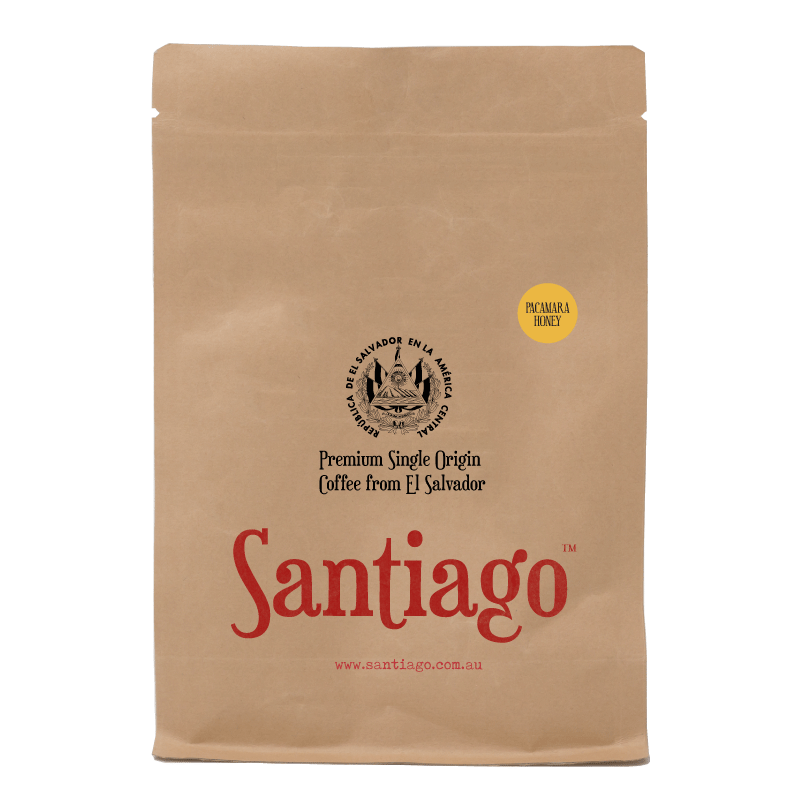The Pacamara coffee varietal is the result from the crossing of Pacas – a mutation of the Bourbon coffee plant, and the Maragogipe coffee plant known for it’s enormous bean size.The idea was put forward to blend the characteristics of the delicate but fascinating Maragogipe with the robust and reliable Pacas at the Salvadoran Institute for Coffee Research (ISIC) back in 1958. It took around 30 years of careful scientific research to create the Pacamara varietal. It was named PACAMARA in reference to the first four letters of each parent varietal. It was released to coffee producers in the late 1980’s.

The Pacas side of the story
The Pacas varietal was discovered by Fernando Alberto Pacas Figueroa in 1949 at the San Rafael farm in El Salvador. Amongst his rows of Bourbon coffee trees, Fernando found plants which were different to the others as they were shorter, denser, and heavy with fruit. Their compact shape made them resistant to environmental challenges and found the yield to be up to 20% higher than the regular Bourbon. In respect to flavour it very much echoed Bourbon – sweet and well-rounded.
Fernando proceeded to plant this new tree across one section of the farm, giving it the nickname ‘San Rafael’. Years later a visiting botanist from the University of Florida took samples and found the plant to be a natural and spontaneous mutation of the Bourbon varietal. The botanist chose to honour the farmer who had made the discovery, christening the plant varietal ‘Pacas’.
The Maragogipe side of the story
The Maragogipe (or Maragogype) has its origins in Brazil, in the northeastern state of Bahia. It is a mutation of the Tipica varietal and is nicknamed “elephant beans” for it tall trees, large leaves and huge cherries which makes for beans that are enormous – the biggest of all known coffee breeds. When grown at high altitudes, and with proper care, the Maragogipe can be a very fine coffee with delicate aromas, complexity and balance.
The Maragogipe cup quality is remarkable however the yield is very low and for this reason have become a rarity on coffee farms. This relative scarcity combined with the potential for unique and beautiful flavours has made theses monster beans a quirky favourite amongst coffee aficionados.
When the two combine

At the Salvadoran Institute for Coffee Research (ISIC) back in 1958, scientists blended the characteristics of the delicate but fascinating Maragogipe with the robust and reliable Pacas. The process encountered setbacks but now the Pacamara is what is referred to as ‘genetically unstable’ – between 10% and 12% of Pacamaras will revert to the parent varietal Pacas and is susceptible to every coffee problem known to man – leaf rust, berry disease and insects. The Pacamara is a medium-sized tree with thick foliage, short internodes, and large leaves. The cherries it produces are long and have a small protuberance, and the seeds are large and oval in shape.
However farmers persevere as the combination of the sweetness of the Pacas with the complex and intense aromas of the Maragogipe makes for a cup that surpasses both it’s parents. The Pacamaras cup leans toward a medium body, with a rich creaminess, balanced with an elegant and fine acidity, with flavours that swing from sweet notes of chocolate, butterscotch or caramel flavours to fruitier undertones of citrics, red berries and stone fruits.
 Try our Pacamara Honey coffee with brown sugar sweetness, tones of malty chocolate and cocoa from our online store.
Try our Pacamara Honey coffee with brown sugar sweetness, tones of malty chocolate and cocoa from our online store.
1 Comment